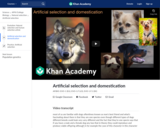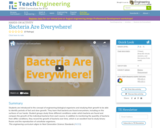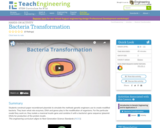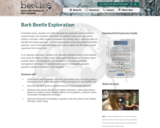
Using the Hardy-Weinberg equation to calculate allele and genotype frequencies. Created by Sal Khan.
- Subject:
- Biology
- Life Science
- Material Type:
- Lesson
- Provider:
- Khan Academy
- Provider Set:
- Khan Academy
- Author:
- Sal Khan
- Date Added:
- 06/23/2014

Using the Hardy-Weinberg equation to calculate allele and genotype frequencies. Created by Sal Khan.

See the many birds that spend their summer in the Arctic in this video segment from Nature.

This video segment from Wild Europe: "Wild Arctic" explores the struggle for survival in one of Earth's most extreme environments.

This video segment adapted from NOVA features a variety of scientific perspectives on the age old question, "Are we alone in the universe?" Animations make vivid the improbability that we could intercept a radio wave signaling extra terrestrial intelligence.

This activity explores what it means for a computer to be intelligent and introduces the topic of what a computer program is and how everything computers do simply involves following instructions written by (creative) computer programmers. Learners interact with a piece of paper that contains rules for playing a perfect game of noughts-and-crosses (tic-tac-toe). The activity contains some thought provoking (and humorous) discussion questions. Explanation, variations, extensions, and resources are included in the PDF.

How humans have shaped plants and animals through artificial selection and domestication.

This video segment explores the benefits and pitfalls of cloning as a means of reproduction. From Evolution: "Why Sex?"

Binary fission, budding, mitosis, fragmentation, parthenogenesis and sexual reproduction.

In this feature, adapted from Interactive NOVA: "Earth," students explore the relationship between oxygen concentration and the well-being of various organisms by simulating a change in oxygen levels and observing what happens.

The impact of natural disasters is made vivid in this video segment adapted from NOVA. A small town in Iceland, prepared for recurrent avalanches, is devastated when one takes a new and damaging path.

Students are introduced to the concept of engineering biological organisms and studying their growth to be able to identify periods of fast and slow growth. They learn that bacteria are found everywhere, including on the surfaces of our hands. Student groups study three different conditions under which bacteria are found and compare the growth of the individual bacteria from each source. In addition to monitoring the quantity of bacteria from differ conditions, they record the growth of bacteria over time, which is an excellent tool to study binary fission and the reproduction of unicellular organisms.

Students construct paper recombinant plasmids to simulate the methods genetic engineers use to create modified bacteria. They learn what role enzymes, DNA and genes play in the modification of organisms. For the particular model they work on, they isolate a mammal insulin gene and combine it with a bacteria's gene sequence (plasmid DNA) for production of the protein insulin.

In this lesson students will learn that the food they are eating contain a variety of things such as nutrients, vitamins, fats, and sugars.

In forested areas, students are often intrigued by mysterious sticks covered in carved tunnels–but students often think the patterns were made by human artists or termites. After students complete this activity, they’ll have the skills to identify bark beetle galleries, to make explanations about the patterns of beetle galleries, and to interpret what these tracks tell us about the life history of the organisms that made them.
In an optional discussion, students can consider outbreak levels of bark beetles that cause the death of many trees, make arguments based on evidence about possible effects on ecosystems, then brainstorm and critique possible management strategies. An optional extension for investigating student questions about bark beetles is also included.

This video segment from the Nevada Department of Wildlife looks at various species of bats and how they impact the environment.

This Nature video segment focuses on the four foods most important to the grizzly bears' survival, and it describes the threats to the supply of each of them.

In this video segment from Nature, learn about the problems bears are creating on ranch land surrounding Yellowstone National Park.

This Nature video segment explores how the relationship between humans and grizzly bears has changed over the course of American History, and it describes the closing of the Yellowstone National Park garbage dumps in the 1970s.

Learn about the precautions humans must take in the face of a growing grizzly bear population in this video from Nature.

This video segment explores the world of the beaver, including the biology of the species and, more importantly, its ability to transform an ecosystem for its own benefit.